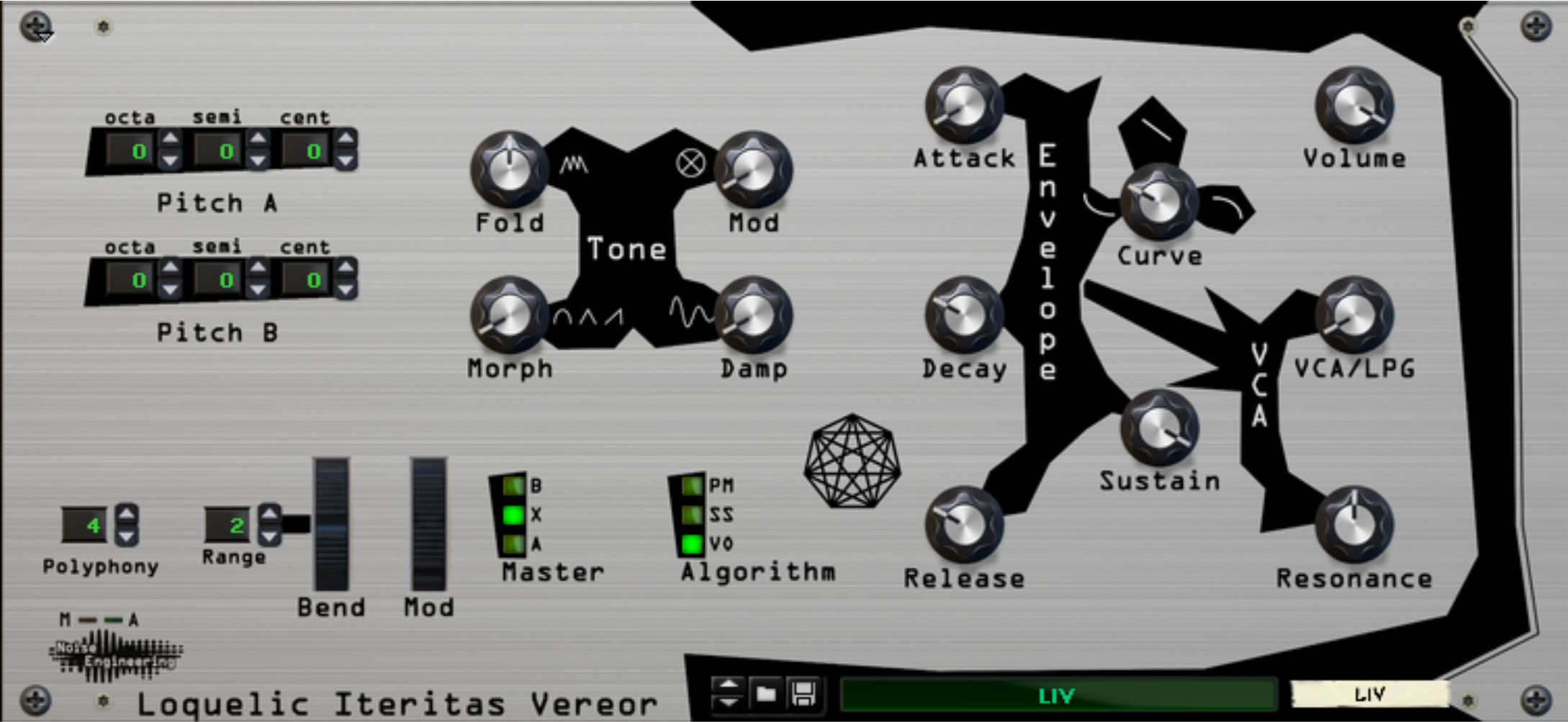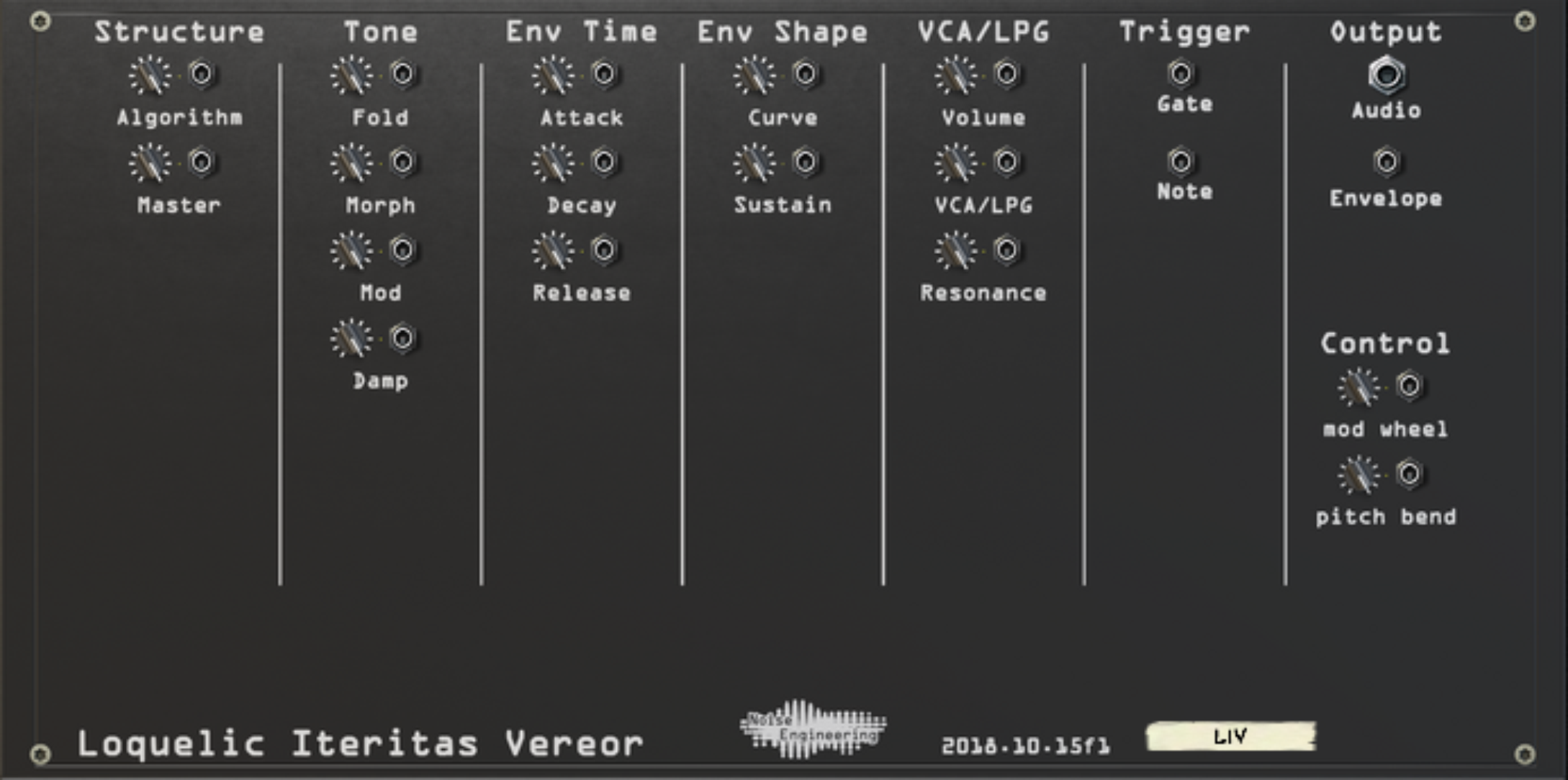Loquelic Iteritas Vereor Manual#
Multi-algorithmic oscillator modulation synth rack extension
Overview#
Loquelic Iteritas Vereor is a synth based around a structure similar to that of classic "complex oscillator" systems, but with a completely new and modern edge. Each oscillator has independent pitch and sync settings, and using the mode selection and tone-shaping parameters the oscillator's shapes and interactions can be continuously shifted and shaped before they're sent to the final VCA/LPG dynamics section. LIV can create sounds ranging from soft and melodic to atonal and distorted. Corny taglines aside, this one's really cool.
LIV offers three different modes: a form of phase modulation, a modified summation synthesis, and a modern implementation of VOSIM. Each has unique and interesting character, making LIV extremely versatile and unlike much else out there.
Front & back panel controls#


- Pitch A/B
- Adjusts the pitch of the fundamental oscillator. Define octave, semitone, and cent.
- Master
- Controls the sync of the oscillators. When in the middle position both oscillators are free running. When A is selected, oscillator B will sync to oscillator A; when B is selected, A syncs to B.
- Algorithm
- Controls tone-generation algorithm (see below).
- Curve
- Adjusts the curve of the envelope stages from exponential to linear to logarithmic.
- Bend Range
- Adjusts the maximum pitch-bend range in semitones.
- Bend
- Visual indicator of MIDI pitch-bend wheel.
- Mod
- Visual indicator MIDI mod wheel. Mapped to 20% Fold and 100% Tilt.
- Volume
- Adjusts the level of the Rack Extension.
- Preset load/save
- Click the folder button to open a preset. Use the arrows to toggle through presets. Use the disk button to save a preset.
- Polyphony
- Sets the maximum number of voices. When maximum is set to 1, portamento is enabled.
- Envelope & VCA
-
VCAs and LPGs are devices common in the hardware world but aren't presented in the same way in software. A VCA (voltage-controlled amplifier) controls the amplitude of a signal. Most often, they are used in conjunction with envelopes to control the volume of a sound. In this synth, it is controlled by the ADSR envelope; when a note is triggered, the envelope rises through the Attack stage, opening the VCA and letting the sound generated by the oscillators through. As the note is held down, the envelope then cycles through the Decay stage down to the level set by the Sustain, holding the oscillator at a specific amplitude. When the note is let go, the envelope closes at a speed set by the Release, closing the VCA and silencing the oscillators.
A LPG (Low Pass Gate) is a combination of a VCA and a low pass filter. Combined, they control both the amplitude and harmonic content of a sound. The filter behaves similarly to the VCA and follows the envelope, opening and closing as the envelope cycles.
- Attack
- Adjusts the envelope rise time.
- Decay
- Adjusts the envelope decay.
- Sustain
- Sets the level decay falls to.
- Release
- Sets the latency before the envelope falls when a note is released.
- Curve
- Adjusts the curve of the envelope stages from exponential to linear to logarithmic.
- VCA/LPG
- Mixes between a clean VCA and low pass gate. While useful at the two extremes, delicate harmonic shaping can be achieved with the right mix of VCA and LPG.
- Resonance
- Adjusts the resonance of the LPG. This parameter will not affect the sound of the synth if the VCA/LPG mix knob is set fully to VCA.
- Tone controls
- The function of the tone controls varies slightly in the three algorithms.
Note
All front-panel knobs act as offsets that sum with CV inputs and all back-panel knobs act as attenuators.
Back panel only controls#

- Trigger
- Gate - input to trigger the module.
- Trigger
- Note - CV input to specify note.
- Output
- Envelope - a CV output that tracks the current envelope level.
- Output
- Audio - monophonic output.
Algorithm VO#
The VO algorithm is roughly based off of the VOSIM algorithm mentioned in Curtis Roads's Microsounds. VO amplitude modulates a carrier by an exponential to create a complex harmonic structure. The simplest carrier is a sinusoid which produces a spectrum with a Gaussian distribution centered on the carrier. More complicated waveforms produce Gaussians around each harmonic, producing spectra similar to comb-filtered noise. Pitch A is the fundamental frequency of the carrier. Pitch B is the retrigger frequency of the exponential decay.
Morph: Changes the waveform of oscillator A.
Damp: Sets the decay constant on oscillator B relative to its period.
Mod: Phase-modulates oscillator A by oscillator B.
Fold: Sets the wave fold threshold on the final wave folder.
Algorithm SS#
Algorithm SS is a highly modified version of summation synthesis originally developed by James Moorer. The premise comes from a simple mathematical equality between an infinite harmonic series and a relatively easy-to-compute expression:
This equation allows a wide variety of musical spectra to be produced by only two parameters. LIV generalizes the sinusoidal terms into multi-waveform oscillators: two of these track the two input pitches while the third tracks the difference of the two pitches and adds a wave folder for more harmonics. In the equation oscillator A is the left sinusoidal term in the numerator. Oscillator B is the sinusoidal term in the denominator. The equation becomes:
- Morph
- Changes the waveform of all oscillators.
- Damp
- Sets the a parameter in the equality. This controls the generated spectra with higher values producing higher-power harmonics.
- Mod
- Phase-modulates oscillator A by oscillator B.
- Fold
- Sets the wave-fold threshold on the final wave folder.
Algorithm PM#
The PM algorithm is a naive time-domain two-oscillator phase-modulation implementation that combines both oscillators with amplitude modulation.
- Morph
- Changes the waveform of both oscillators.
- Damp
- Blends between oscillator A and B through their product (amplitude modulation).
- Mod
- Phase-modulates the oscillators by each other.
- Fold
- Sets the wave-fold threshold on the final wave folder.
Special thanks#
Our Beta testers improved the look, feel, and function immensely and we are in their debt.
Beta testers for Synth Bundle 2 include:
- Markus Cancilla
- Mattias Haggstrom
- Alan Strahsburg
- Paul Rostill
- Navi Retlav
- Akos Botos
- Craig Stanton
- Nils-Erik Johansson
- Michael Gorman
- Kirk Markarian
- tl3ss